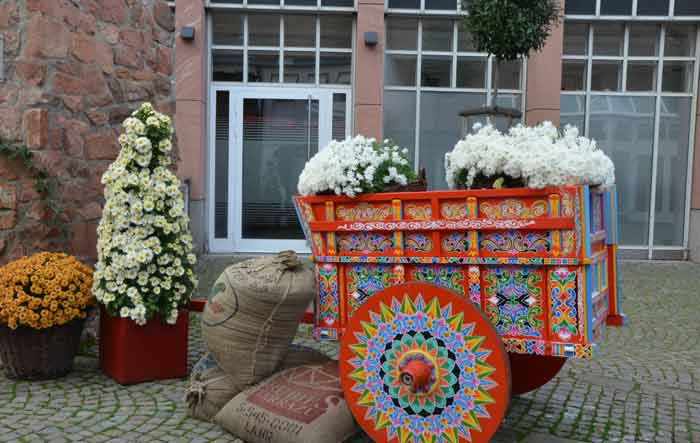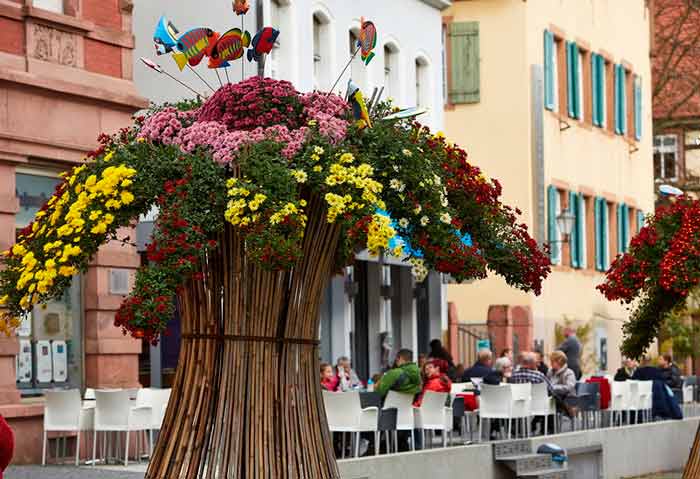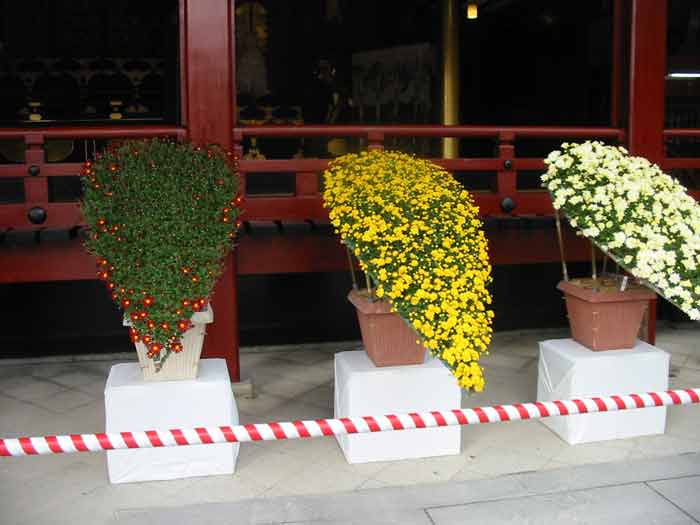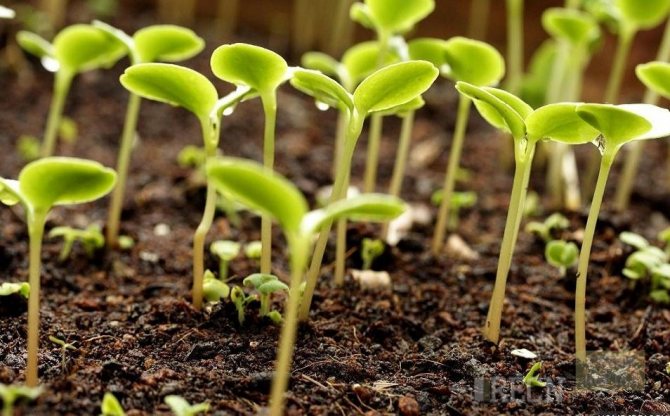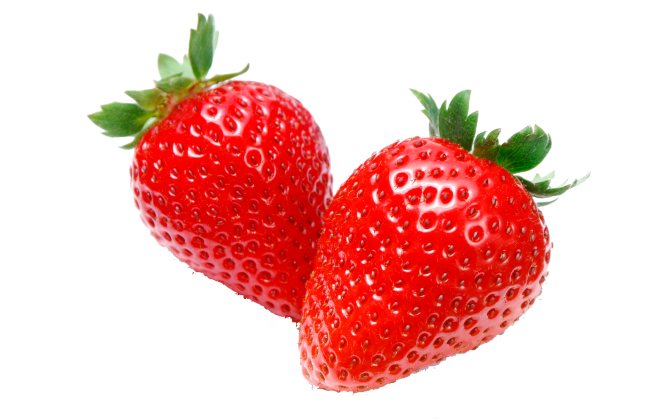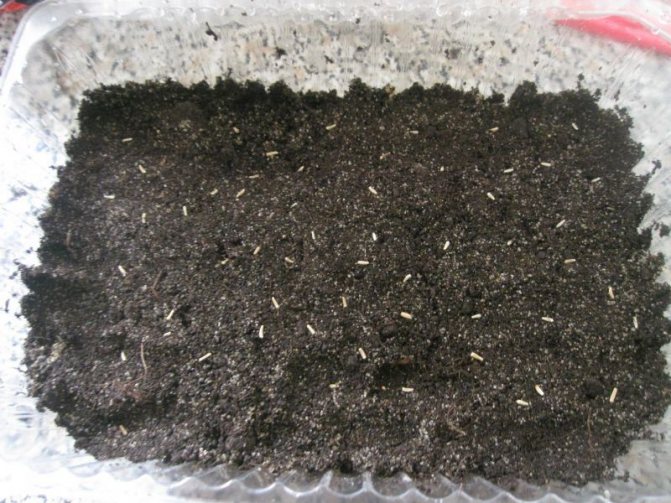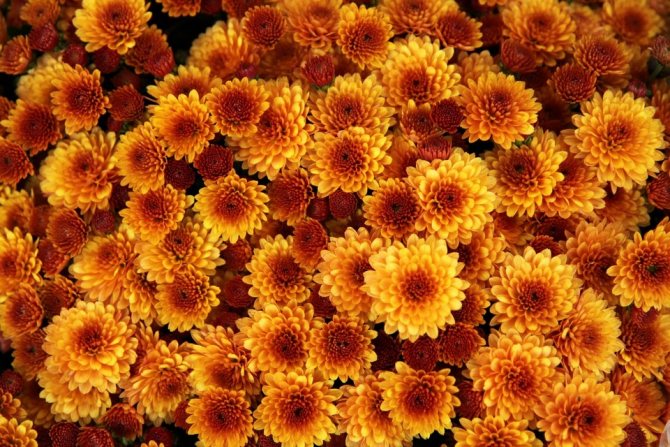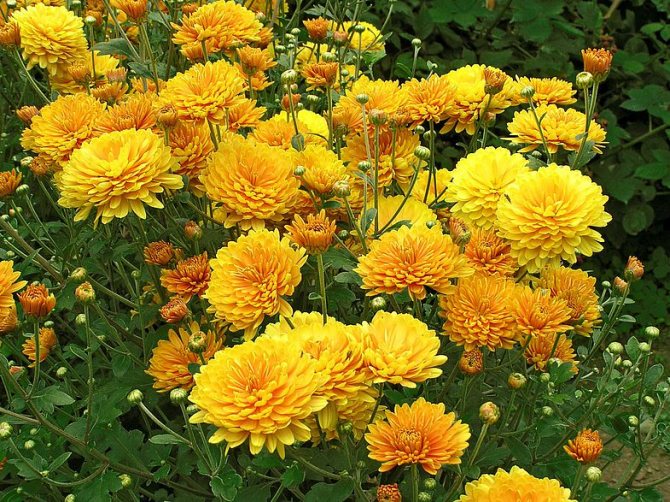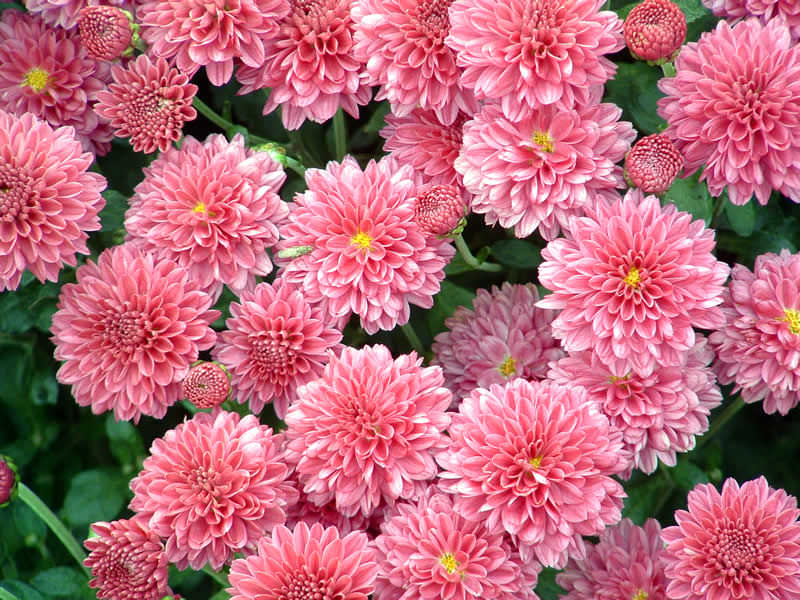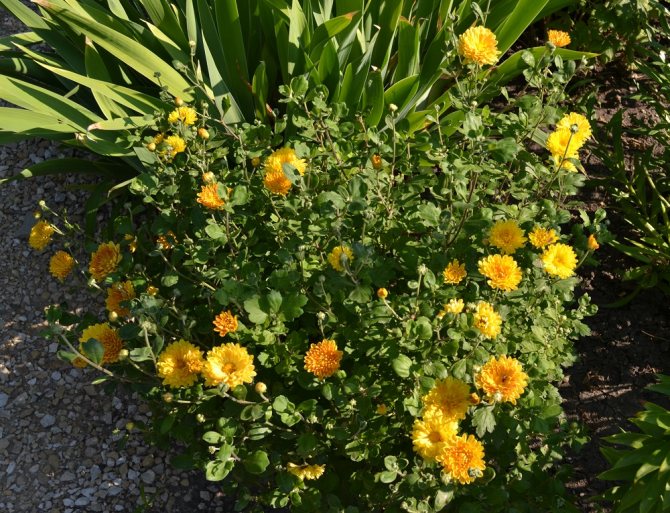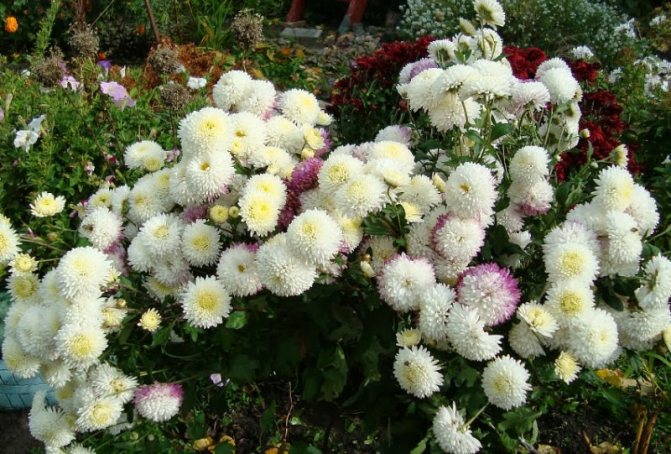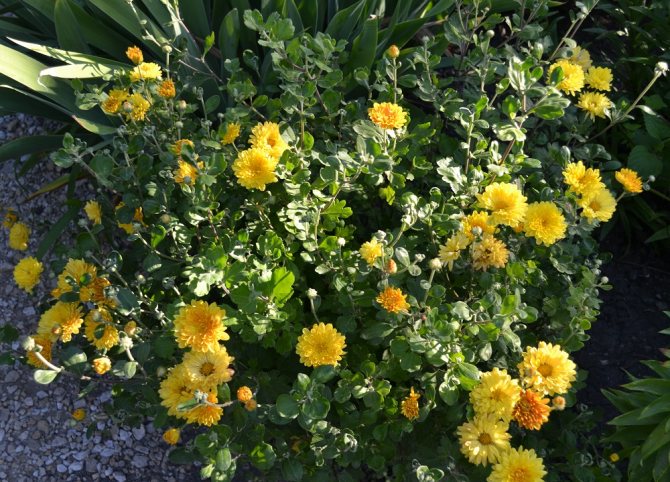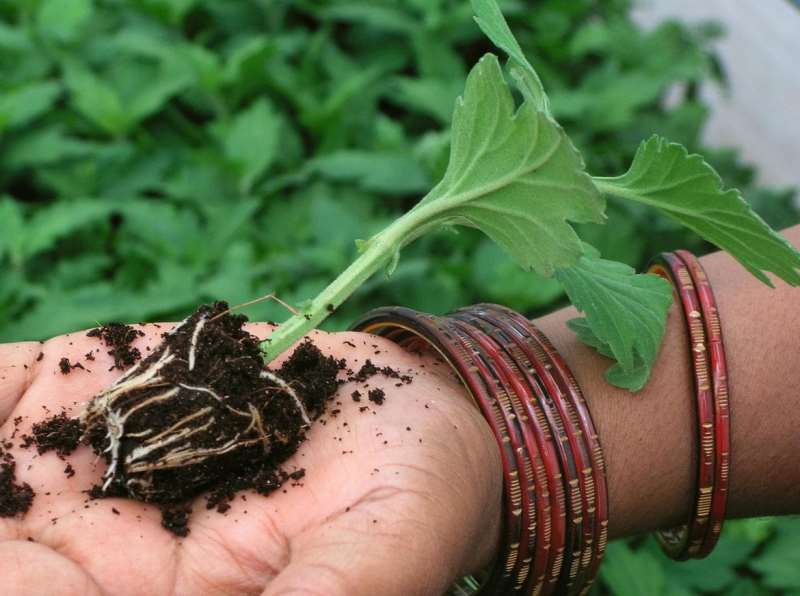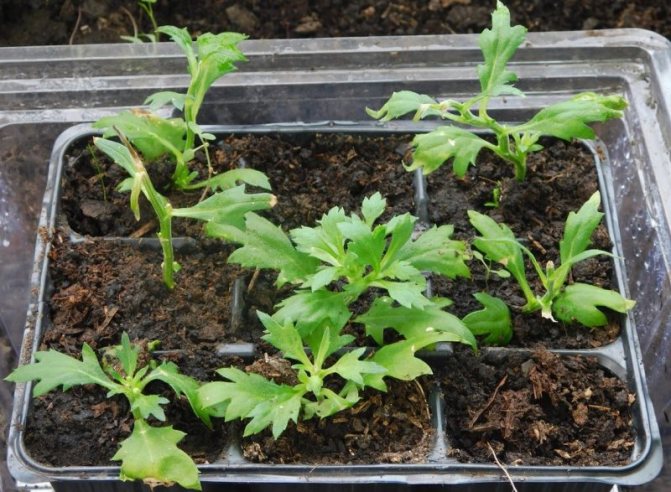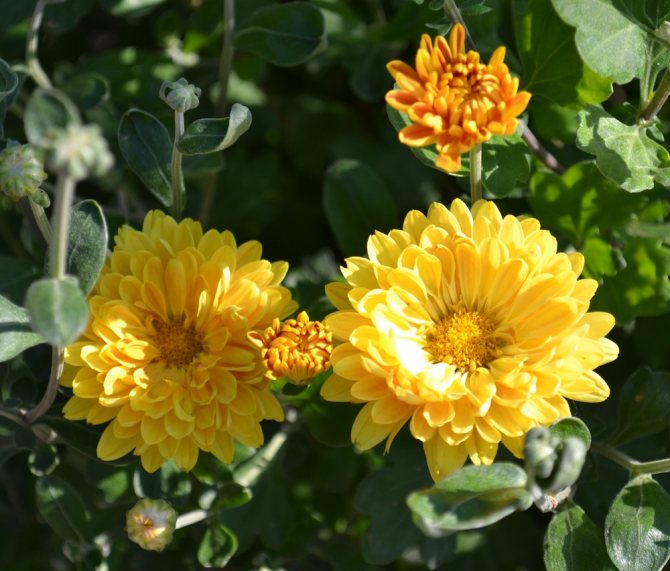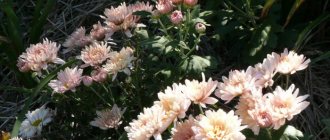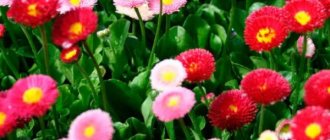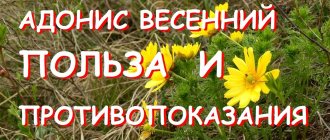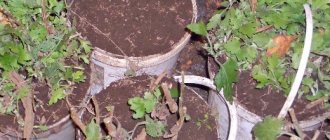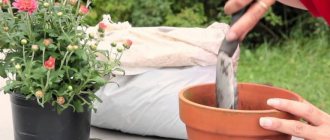Queen 1.
In 2007, the ‘Anastasia’ variety became the queen of the ball. An exquisite variety of English selection. A stunningly beautiful white inflorescence, radial, with a diameter of 14-15 cm. The plant is 90-100 cm high. A variety of average flowering period (3rd decade of October). Good for cutting. Introduction (introduction to culture) of Nikitsky Botanical Garden (NBS-NSC) 2007. Photo by N.V. Smykova.
Queen 2.
In 2008, the ‘AmiPaulette’ became the queen of the ball. A chic variety of French selection. The inflorescence is lilac-lilac, anemic, with a diameter of 16-18 cm. The plant is 90-110 cm high. The variety has an average flowering period (3rd decade of October). Good for cutting. Introduction of NBS-NSC 1974

Photo by Yu.G. Kopan
Queen 3.
In 2009, the ‘Swallow’ (‘Yan-Tzu’) variety became the queen of the ball. A beautiful variety of Chinese selection. The inflorescence is white, simple, chamomile, with a diameter of 16-18 cm. The plant is 70-80 cm high. A variety of medium-late flowering period (1st decade of November). Good for cutting and decorating the site. Introduced by NBS-NSC 1974. Photo by Yu.G. Kopan.
Queen 4.
In 2010, ‘Reflex’ became the queen of the ball. Excellent variety of English selection. The inflorescence is white, spherical, double, 13-14 cm in diameter. The plant is 90-110 cm high. Variety of early-middle flowering period (2nd decade of October). Good for cutting. Introduced by NBS-NSC 2007. Photo by Yu.G. Kopan.
Queen 5.
In 2011 ‘EscortRot’ became the queen of the ball. An amazing variety of English selection. The inflorescence is bronze-red, hemispherical-bent, with a diameter of 14-15 cm. The plant is 80-90 cm high, the stem is strong, densely leafy. Variety of early-middle flowering period (2nd decade of October). Good for cutting. Introduction of NBS-NSC 1976
Photo by Yu.G. Kopan
Queen 6.
In 2012, the ‘Orange Ball’ variety became the queen of the ball. A luxurious variety of foreign selection. The inflorescence is bright yellow, hemispherical, 15-16 cm in diameter. The plant is 100-110 cm high, the stem is strong, densely leafy. Variety of average flowering period (3rd decade of October). Good for cutting. Introduction of NBS-NSC 2006
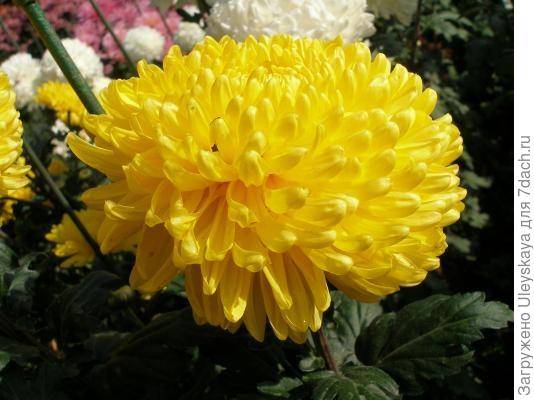

Photo by Yu.G. Kopan
Queen 7.
In 2012, in addition to the queen of the ball, 2 vice-queens were elected. 1st Vice Queen is an interesting 'Kiko' variety. The inflorescence is light purple, spider-lucid, large, with a diameter of 20-22 cm. The plant is 80-90 cm high, the stem is strong, well leafy. Variety of medium-late flowering period (1st decade of November). Good for cutting. Introduction of NBS-NSC 2011


Photo by Yu.G. Kopan
Growing from seeds
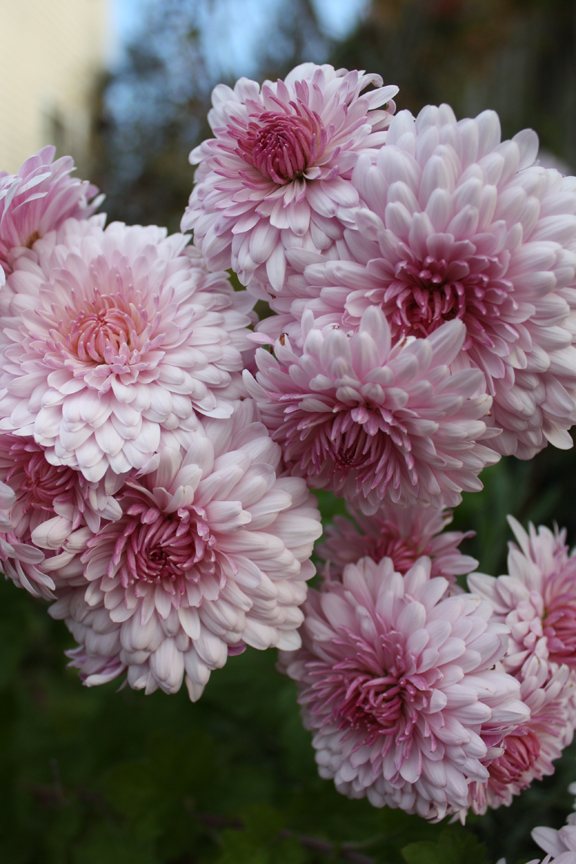

Chrysanthemum Emperor of China
The "Japanese miracle" can be propagated by two methods: vegetatively and by seeds. Seed flowers tolerate low temperatures better, but may partially lose their varietal qualities.
You can plant seeds directly into the ground, you can use the seedling method.
The easiest way is to plant seeds in the ground. You will see the fruits of your labor late: only at the end of summer. And you need to act as follows:
- We dig small holes through 25 cm, pour with warm water,
- Place 3 seeds in each hole, sprinkle with soil on top.
- If it's cool, then cover with agrofibre on top. At the first shoots, we remove the shelter.
- Traditional care: thinning, weeding, loosening.
- Leave one sturdy plant in each hole. The rest can be removed or transplanted.
- In the process of growth, we feed with complex fertilizer.
Growing through seedlings should start no later than February, since the Korean chrysanthemum will bloom only after 6 months. Therefore, in February
- We fill in the soil in a container with a height of 6-8 cm.
- We distribute the seeds over the surface and cover them with river sand with a layer of 1 cm.
- Gently moisten so that the seeds do not "go" deep into the soil and cover with glass. We remove the glass from time to time for airing.
- Seedlings should appear in 2 weeks at a temperature of +18.
- We water and feed regularly. To prevent the seedlings from stretching, we highlight them.
- We dive into peat pots (you can use any containers) in the presence of three real leaves.
- We plant the place chosen for flowering in May (+15 degrees), maintaining a gap between plants -20 cm, between rows - 30 cm.
It is necessary to know: the Korean chrysanthemum is the only one among its “congeners” that can withstand low temperatures. In the southern territories, it hibernates without shelter, in the middle lane and in the northern regions, it needs to be sheltered in the winter. Flowering begins in early August and ends in late October. Therefore, it is called the "flower of autumn".
How to get chrysanthemum seeds
Chrysanthemum seeds are available for sale, but you can collect them yourself. In this case, you should know:
- Seeds from small simple and semi-double flowers are easier to collect and their germination is good, but large-flowered varieties are difficult to breed in this way, because they produce very little seed.
- Quality seeds produce early and medium flowering chrysanthemums. In late-flowering chrysanthemums, the seeds do not ripen.
So, in order to get seeds from the plant you like:
- we plant it in the spring in the garden as early as possible;
- water regularly, feed;
- stepchild;
- we make sure that from 5 to 8 stems remain on a small chrysanthemum, and no more than 3 on a large one;
- pinch, leaving only 1 bud on one stem. This improves the quality of the seeds and increases their number.
From plants that bloom in mid-summer, seeds are harvested while they are in the garden. With those that continue to bloom in the fall, you should do this:
- Cover the bush with foil so that the flowers do not get wet if it is not possible to move it to the greenhouse.
- Before freezing, transplant the chrysanthemum into a pot, bring it into the house and place it on a sunny windowsill. If the bush is grown in a greenhouse, then the receptacle can spoil the condensation. To prevent this from happening, protect it with gauze or agrofilm.
- Collect the seeds as soon as the baskets are brown. This usually happens in late November and early December. Do not be late, otherwise they will crumble themselves.
Important: if the petals of your chrysanthemum are so long that they cover the middle, then they must be trimmed as they grow. So the place where the seeds are located will be better illuminated and ventilated, which will prevent rotting.
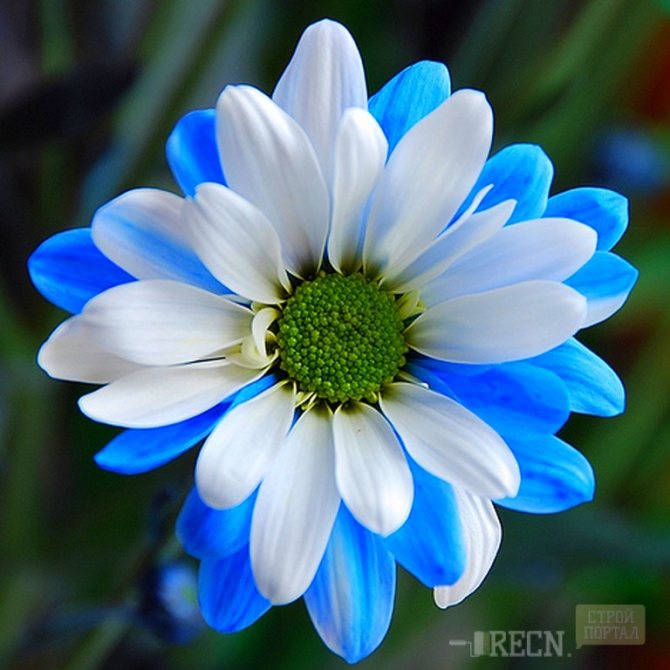

The most common varieties
Korean chrysanthemum, the varieties of which are very diverse, loves warm and lighted places. Does not tolerate shade and an abundance of moisture (the presence of near groundwater). It is better to plant in high flower beds, then the flowering of any varieties will delight you with its abundance.
Names and characteristics of the variety:
Bayram: bush 60cm in height. It begins to bloom early - at the end of July. The entire flowering period is 80 days. Lilac inflorescences of medium size have a specific aroma, for an amateur.
Anastasia: bush less than half a meter with an average (6cm) diameter of a semi-double flower. Interesting in that it can change the shade from terracotta to crimson. The color saturation is also different.
You need to know: By pinching some of the buds, you can get flowers on a plant of much larger sizes.
Korean: a half-meter bush sprinkled with small flowers of an unusual color - terracotta orange.It does not tolerate shaded areas, but it is unpretentious to the weather and can bloom in winter in the southern regions.
Chamomile: chrysanthemum for lazy gardeners. It blooms early and is characterized by rapid growth, unpretentious care. Her color is not “chamomile”, but red-orange.
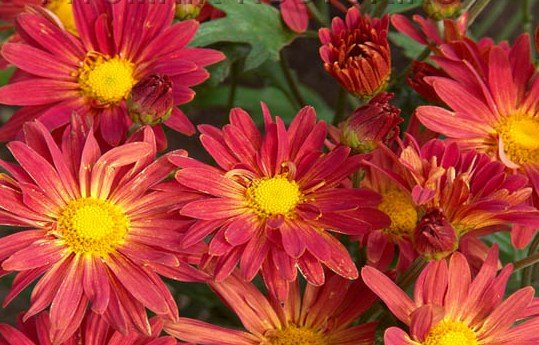

Korean chrysanthemum chamomile
Umka: tall bush with large flowers. With prolonged flowering, the color of the flower changes from white to lilac. The center is always creamy. Refers to pompom varieties.
Purple Haze: Has a standard height and medium flower sizes. Differs in rapid growth and reproduction. Terry, lilac flowers fit tightly to each other. One of the most frost-resistant varieties.
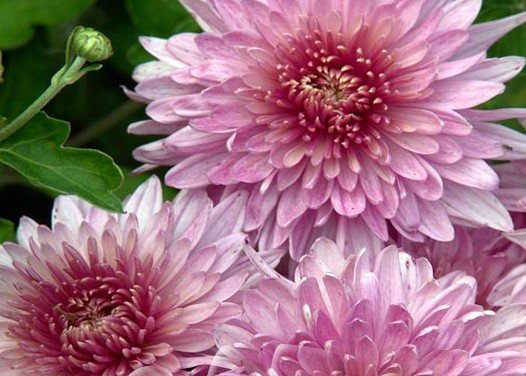

Purple Haze
This is interesting: Chrysanthemum is deservedly considered the main flower of autumn. The Japanese who revere this plant. A chrysanthemum festival is held, where you need to admire flowers and reflect on the meaning of life. If a flower is given, then red symbolizes love, white - truth, and yellow - rejected love.
From my experience.
I have successfully grown Korean hybrids from seeds, resulting not only in different colors, but also in height and flowering times of the plant.
Korean hybrids, as a rule, are bushes with non-double chamomile inflorescences. And I personally like such simple flowers more than inflorescences stuffed with petals. Cheerful yellow middle buttons, shading the edge petals of any color, always evoke some kind of tenderness and nostalgia for wildflowers.
I also grew low pillow chrysanthemums from English seeds. In the first year in the fall, they bloomed. Also it turned out several colors. Pillow chrysanthemums are adorable, but from the very first winter they began to die and after the third winter there were not a single one left.
I would also like to note such a nuance in the characteristics of chrysanthemums. With rare exceptions, we have dry and very hot summers. It would seem that the heat-loving chrysanthemum beauties, warmed by the sun, should bloom earlier. But this is not happening. They bloom, at best, in the middle of autumn and do not even have time to bloom until frost.
Chrysanthemums slow down the growing season in hot dry seasons. They, like plants with a short daylight hours, are waiting for less light, when cloudy days come, which will be the impetus for coloring and blooming buds. After cooler, rainy summers, chrysanthemums bloom earlier than usual.
I would like to compare chrysanthemums with perennial asters. The comparison will be appropriate, since they bloom at the same time, and chrysanthemums also perform their "aria" in the autumn garden.
In general, chrysanthemums bloom later than asters. There are varieties that do not want to bloom in early November, while all types of asters always bloom before the end of the season.
Reference by topic: Preparing chrysanthemums for wintering
Chrysanthemum mixtures
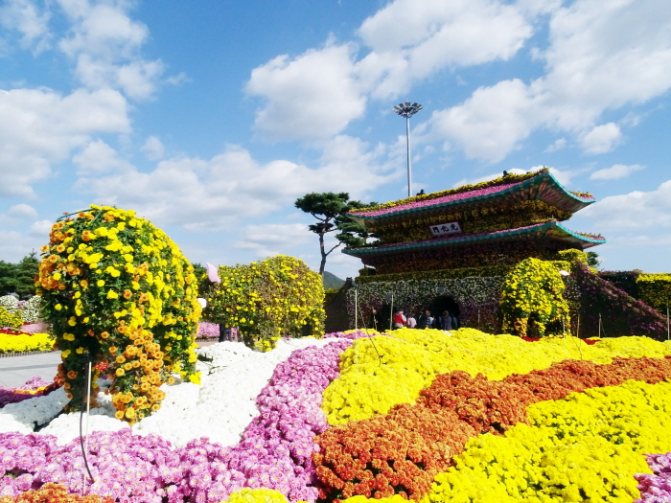

Big Chrysanthemum Festival in Hampyeong, South Korea.
It is more profitable to buy chrysanthemums in a mixture, since you will immediately acquire different colors: a motley, multi-colored carpet. You may be offered:
Chrysanthemum korean mix: grows in greenhouses and outdoors. Erect plant of medium height. Inflorescences of different colors and different types of inflorescences: from simple to double. Well worth the cut. Combines with conifers and ornamental grasses. They are also used as a pot culture. Blooms throughout August-September.
Chrysanthemum Korean Velvet Autumn: The culture is good bush, forming numerous basal offspring. A variety of colors and large double flowers are visible from afar and attract attention. In group plantings, it goes well with coniferous shrubs. It stands for a very long time. Winter-hardy, but needs to be covered with spruce branches.
Mixture Stars of the galaxy: Compact shrubs can be planted in containers or outdoor pots.Spectacular and long-lasting flowering can be observed until late autumn. Large, double inflorescences will delight their owners until the end of October. Flowering until frost resistant. They stand in the cut for a long time.
It is not so easy to find descriptions of Korean chrysanthemum varieties with exact photos and names on the Internet. The fact is that the range of greenhouse farms varies significantly, there are many varieties of Korean chrysanthemum, many amateurs collect collections, and then give their own names to unidentified varieties and send them for sale under that name. Photo titles in this article are as accurate as possible.
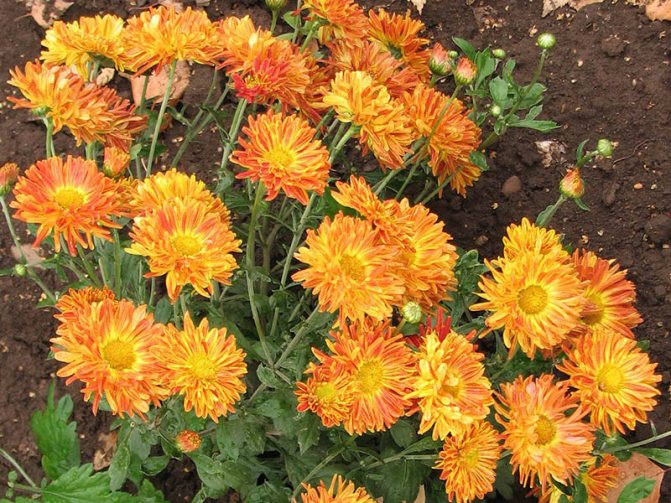

Chrysanthemum Korean Watan
Classification of varieties of Korean chrysanthemums
There is no established and fixed classification of garden chrysanthemums. They are often divided according to individual characteristics, mixing either the size of the flowers, then the height of the bush, then the frost resistance.
There are annual types of chrysanthemums that are not related to perennial Korean hybrids. The latter may differ in height, size of inflorescences, number of petals, etc., but they are all perennials. By height, hybrids are divided into:
- tall: from 55 cm;
- medium-sized: 45-55 cm;
- undersized: up to 45 cm.
The latter variety is often called curbs, since it is convenient to arrange garden paths with bushes of low, abundantly flowering plants. And sometimes hide an ugly border.


Low-growing hybrids are often grown as a home pot culture. "Koreans" grow well in the apartment.
The second type of division according to the shape of the inflorescences into:
- simple;
- semi-double;
- terry.
The simple inflorescence is the same as in wild forms, but cultivars can be of any color. The term "spherical" means that the flower is three-dimensional as in the photo below.


The third type of division of plants according to the size of flowers: small, medium and large. The fourth - in terms of flowering time: early ripening, mid-ripening and late-ripening.
Important! Seeds of late-flowering hybrids do not ripen.
But even early varieties are more efficiently propagated in any other way, but not by seeds.
Early Korean Chrysanthemum Varieties
All chrysanthemums are autumn flowers. But even among them there are "congeners" blooming earlier or later. Some bloom for no more than 30 days, others can please the eye for a couple of months. Among the early "Koreans" are:
- Lelia - from July to September;
- Pamela Brons - from August to October;
- Novella - coloring of buds from the end of July, beginning of flowering - August, ends blooming in October;
- Apple blossom # 1 - from August;
- Apple blossom # 2 - from the beginning of August.
Both Apple blossoms finish blooming in October.
Varieties of spherical Korean chrysanthemums
Among Korean hybrids, the term "globular" has another meaning. By this word, lovers of small long-flowering bushes mean the shape of the plant itself. The globular “Koreans” are often grouped under the name “multiflora”. They do not require formation and themselves grow in the form of a spherical bush. In autumn, such a "ball" is strewn with flowers of all kinds of shapes and colors.


Almost all varieties of multiflora appeared in Russia recently and do not even have their own names:
- Branbeach - yellow, orange, purple, white The size of the terry inflorescences is 4.5-7 cm.
- Double yellow flowers have a diameter of 3-7 cm;
- Branfountain - white, purple, coral, lemon Terry inflorescences, diameter 4 cm.
- Brandroyal - red, pink, yellow, white. The flowers have a very rich bright color. Diameter 4-5 cm.
- Branhill - light pink and dark red. Terry flowers, 3-5 cm in diameter.
- Inflorescences with a diameter of 4 cm, terry. Abundant flowering.
- This variety has not only a spherical bush, but also flowers. The diameter of the double flowers is 2.5-3 cm. The petals are white, the middle is yellow.
Multiflora can also be divided according to the early maturity and height of the bushes.Some of the varieties of multiflora grow up to 70 cm, others remain at the level of 30-40 cm.


Tall korean chrysanthemums
It is profitable to breed tall varieties for sale, since if the bush is not very powerful, then the inflorescences hanging in different directions will make a sloppy impression. The high grades include all those that are above 60 cm:
- Orange sunset - 70 cm;
- Chamomile - 70 cm;
- Vologda lace - 60 cm;
- The sun is 70 cm;
- Aurora - 90 cm;
- Umka - 70 cm.
Certain varieties of hybrids can grow up to 1.5 m.


Frost-resistant Korean chrysanthemum varieties
Gardeners value hybrids for their hardiness, which they acquired from their wild ancestor. Few hybrids are unable to withstand the cold. The standard lower threshold for these hybrids is 20-35 ° C frost. Colds down to - 35 ° С can withstand:
- Lelia;
- Chamomile;
- Vologda lace;
- Sun;
- both varieties are Apple blossom and many others.


Reviews of varieties
Florists share the peculiarities of growing, flowering, care. However, according to the requirements for environmental conditions, the varieties differ little. The main question that concerns Russian chrysanthemum lovers is wintering. And also some moments of landing and choosing a place.
This is a plant that requires careful attention to itself. A warm, lighted place and loose soil are what they need. Compost or humus should be added to the soil. It is better to plant in raised flower beds so that there is no stagnation of water.
Varietal planting material is purchased in the form of cuttings. They are planted in May, after frost. Planting and transplanting is carried out with a closed root system, without damaging it. If the cuttings were purchased at the end of autumn, then it is better to place them in a dry basement for the winter, and plant them in the spring.
You need to know: Autumn planting for these plants is unfavorable. Especially during the flowering period. Most likely, chrysanthemums will die or will be sick for a long time. It is undesirable to disturb them late.
In one place, they can bloom up to 3 years. They love mulching. Pine needles and pine bark are the best mulch, they do not contain spores of pathogenic fungi or bacteria. Since chrysanthemums are characterized by rapid growth, regular feeding is necessary.


Chrysanthemum Lantern Glow
The combination of Korean chrysanthemums with other flowers
When planting, the bushes of "Koreans" are inappropriate to combine with other plants. Many of them look very impressive when planted in the middle of a small grassy lawn. A bush variety of chrysanthemums, formed in the form of a small tree, will look beautiful.
In autumn, compositions from chrysanthemums and their closest relatives of the Aster family look good: vernonias or perennial asters. Chrysanthemums get along well and look great in the company of annual flowering plants:
- ageratum;
- zinnia;
- coleus;
- salvia;
- balsam;
- marigolds;
- calendula;
- snapdragons and other flowers.
By choosing the right plants for the flowering period, you can get a long-flowering composition that will delight the eye until the very frost.


Indoor diseases
If the Korean chrysanthemum is in a potted culture and is at home, then plant diseases are possible, although it rarely gets sick. They are often associated with improper care. But diseases such as powdery mildew, septoria, ascochitis, rust, black leg, fusarium wilting, mycoplasma jaundice, viral speckled veins, viral dwarfism.
Chemicals should not always be used. If the disease is detected at an early stage, then it can be defeated with folk remedies.
Here is such an interesting culture - Korean chrysanthemum, which can grow in greenhouses, at home, in the open field. A variety of flower colors bring positive emotions into our life, the desire to admire the "terry miracle" again and again. Having planted them on your site, the autumn garden will seem like a fairy tale to you.And how can one fail to recall the words of the classic “Beauty will save the world!”.


Korean chrysanthemum Vivat Botaniku
Output
Leave only chrysanthemums with an earlier flowering period in the flower beds in the country. Very late varieties are appropriate for private houses.
Chrysanthemums, unlike asters, do not have blue, blue and purple colors, which bring a "deep dramatic note" to flower gardens. But chrysanthemums come in orange, yellow, terracotta, peach colors, which complement the melody of the autumn garden with warm notes.
Each flower has its own place, each grower has its own perception, its own love for certain colors of the autumn garden.
Autumn asters are not a cut crop: they quickly lose their turgor, the flowers wrinkle (you will not take them to your home from the dacha).
Chrysanthemums, on the other hand, are great in cutting and, after finishing the summer season, you can take away an armful of chrysanthemums. Chrysanthemums will delight you for a long time and will wither only after all the buds have dissolved to the last. But be sure to remove all the leaves from the part of the stems that will be in the water, do not forget to change the water daily, cut the ends of the stems. And do not put bouquets on the windowsill, under which there is a heating battery.
Care rules
Without a transplant, the chrysanthemum plant feels great for about 3 years. For better formation of the root system, the soil must be loosened for the first 30 days after planting. Loosening at a later date can damage the emerging shoots and roots.
She also responds positively to mulching, which prevents infection with fungal diseases. Needles of coniferous trees, straw and finely planed pine bark are perfect as mulch.
Chrysanthemums can grow rapidly.
Watering with fertilizer is carried out only at the root to avoid leaf burns.
Stages of feeding:
- Nitrogen fertilizers after plant adaptation. Promotes the growth of vegetative mass.
- Bird or cow manure 2 weeks after the first feeding.
- At the beginning of bud formation - phosphorus-potassium fertilizers. They increase the plant's resistance to diseases.
A good fertilizer is an infusion of cow dung and chicken manure. To do this, 2 buckets of cow dung and a bucket of chicken droppings must be placed in a large container, filled with water and left for three days. The resulting fertilizer is diluted with water in a ratio of 1:10 and each plant is fed with a liter of infusion.
Topping
Pinching and trimming
It is an important point in the care of this beautiful flower. To obtain a voluminous lush bush, pinch the main stem, leaving 5-6 leaves and stepsons. In the future, they also do it on the grown secondary shoots, leaving 4 leaves each. This applies to tall varieties of chrysanthemums.
In most varieties of chrysanthemums, small buds begin to form almost immediately after planting. To relieve the load from the plant and give it the opportunity to get stronger and increase the leaf mass, they need to be cut off. Pinch the bush throughout June. As a result, there is an increase in the bush due to the growth of lateral shoots.
Important! A month passes from the date of the last pinching to the beginning of flowering.
Knowing this and the varietal characteristics of your plant, you can easily determine the timing of pinching. Low-growing varieties begin to bloom earlier than all, higher ones bloom later.
After flowering and yellowing of the foliage, the bush is cut off, spud and covered for the winter. Spruce branches or cut branches and foliage will serve as a shelter. In the spring, the shelter is removed, old stems are removed. Chrysanthemums are planted every 3-4 years.
Watering
It is very important to organize proper and regular watering of the plant. Even a slight soil drought negatively affects the development of the bush, causing lignification of the stems.Mulching helps to retain soil moisture. It is also important not to overflow the plant in order to avoid decay of the root system. Better to use standing water or rainwater. The next day after watering, the soil must be loosened to improve its air permeability.
You need to water directly at the root, trying not to hurt the leaves and flowers. Mandatory watering is necessary from the beginning of summer, especially when forming buds. During flowering, the intensity of watering should be reduced.
Attention! Insufficient watering leads to woody shoots and a deterioration in the appearance of the flower.
Wintering
To create good conditions for overwintering, the bush is mulched with peat or compost mass. Before the onset of frost, the cut bush is covered with spruce branches.
Description and characteristics
Korean chrysanthemums form compact or spreading bushes, the basis of which are erect stems with side shoots. The root system of plants is branched, and gives abundant root growth... Simple leaves are shaped like oak leaves. The plant has a variety-dependent aroma: subtle and pleasant, or wormwood-like.
Korean daisies are different :
- bush height - undersized (up to 0.3 m), medium-sized (up to 0.5 m), tall (up to 1 m);
- diameter of inflorescences - large-flowered (over 0.1 m) and small-flowered (less than 0.10 m);
- type of inflorescence - anemone, pompom, semi-double and terry, radial, spherical, hemispherical and flat;
- petal structure - tubular and reed.
All plants in late summer or early autumn are abundantly covered with inflorescences. Any bush - small or large, low or tall - is literally strewn with bright flowers.
Step-by-step instructions for sowing chrysanthemums for seedlings
Planting seeds of perennial and annual chrysanthemums for seedlings at home includes, in addition to the procedure itself, several other activities - choosing a planting container, selecting and preparing seeds, preparing a soil mixture. Qualitatively and correctly sowing and all related activities will help you with step-by-step instructions that will tell you about all the steps.
Step one: selection and processing of containers
For sowing chrysanthemums for seedlings, you can use wide and shallow shared containerseg wooden or plastic crates.
If you do not want to waste your time picking, then you can immediately sow seeds in individual volumetric containers, for example, in plastic cups, peat, cassettes, peat tablets.
Before use it is recommended to disinfect containers... You can pour over them, for example, with a solution of potassium permanganate.
Important! The culture does not withstand stagnant moisture, therefore, there must be drainage holes in the containers.
Step two: selection and preparation of seeds
In order to grow a beautiful and healthy chrysanthemum from seeds, it is necessary to plant quality seeds on seedlings. They can self-collect from flowersthat grow with you, ask a friendgrowing a plant on its site, or todrink in the store.
If the latter option is convenient for you, then keep in mind that you should buy seeds in reliable and trusted storeswith good reviews from real buyers.
Chrysanthemum seeds are small, so you need to handle them carefully so as not to accidentally spill everything by. The photo shows what the seeds of this culture look like:
Seeds should be disinfected before planting.... You can do this with solution of potassium permanganate, chlorhexidine, brilliant green (just immerse the seeds in a cloth bag for half an hour in the solution, and then rinse). Or make a solution of the drug Fitosporin and soak according to the instructions.
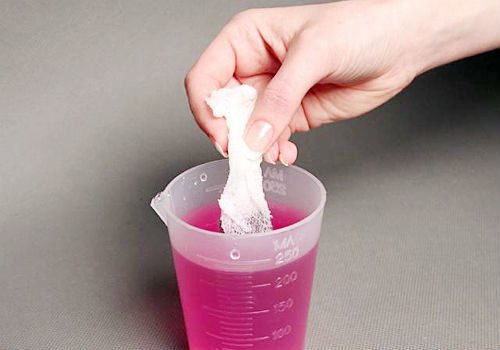

Step three: soil preparation
Chrysanthemum seedlings, like an adult plant, loves loose, light and fertile soil... If it is more convenient for you to use a ready-made soil mixture, then you can buy a universal soil for flower seedlings. And you can make soil with your own hands at home. To do this, mix the following ingredients in equal proportions:
- land from the garden;
- peat;
- humus.
Be sure to prepare the soil before sowing. First of all, you need disinfect the earthto destroy pathogens. Bake it in the oven (30 minutes at 90 degrees) or hold it over steam (1 hour), and then spill it with a solution of the "Fitosporin" preparation.
In order for the soil for growing chrysanthemum seedlings to have a good structure, it is imperative sift it through a sieve.
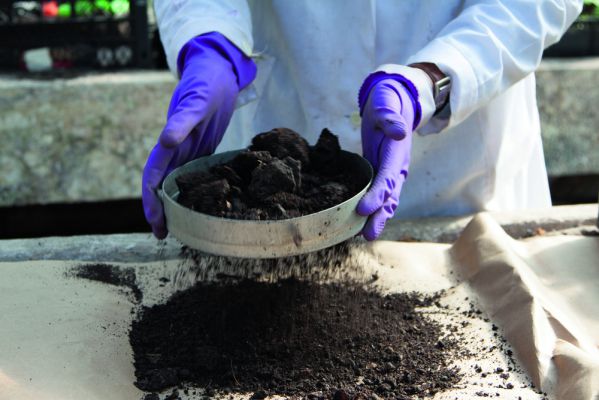

Step four: direct seeding
The scheme for sowing chrysanthemums for seedlings at home in a common box:
- Put a drainage layer on the bottom of the container (no more than 1 cm), for example, sand, small expanded clay.
- Fill the container 2/3 full of soil, moisten with warm water.
- Pour a thin layer of sand on top, moisten the sand again from the spray bottle.
- Sow evenly, the seeds should not be too close to each other.
- You do not need to fill in the seeds from above, they germinate in the light. Just press them gently into the ground with your palm!
- Spray from a spray bottle and place in a warm place with a temperature of 22-25 degrees Celsius.
Note! The sowing technology in individual cups is the same, only 2-3 seeds must be sown in one container. And when the seedlings grow up, you need to choose the strongest, strongest specimen and leave it, and carefully pinch off the rest with scissors.
Sowing peat tablets
You can plant chrysanthemum seeds and peat tablets. To do this, they must first be prepared - left in a pan with warm water for half an hour. When they swell, sow 2-3 seeds in the middle of the tablet. And then also cover with a film or a lid, put in a warm place.
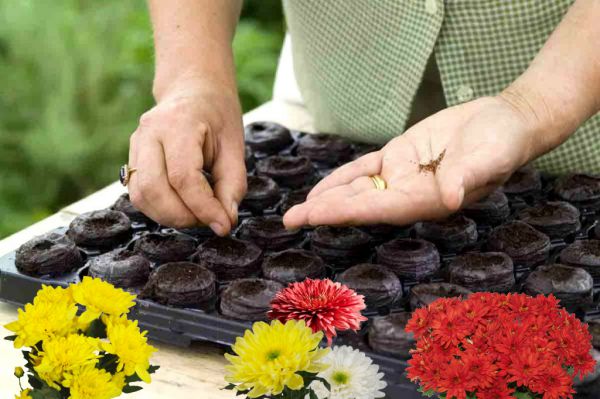

By flowering time
According to this division, all chrysanthemums are divided into the following groups:
- early - bloom in August-September and until mid-October;
- medium - flowering occurs throughout October, slightly captures November;
- late - begin to bloom in the second half of October and November.
Read more about the varieties in each group.
Early
If ordinary varieties of chrysanthemums begin to bloom when the temperature drops to 15-18 degrees and the daylight hours are shortened to 8 hours a day, then the early species are able to please with buds even in summer. To achieve this goal, breeders, through trial and error, have achieved a reduced sensitivity of plants to temperature and light levels.
Anita
Variety with white spherical buds. In diameter, one such "ball" can reach 20 cm, which makes a very impressive impression.
Cremist
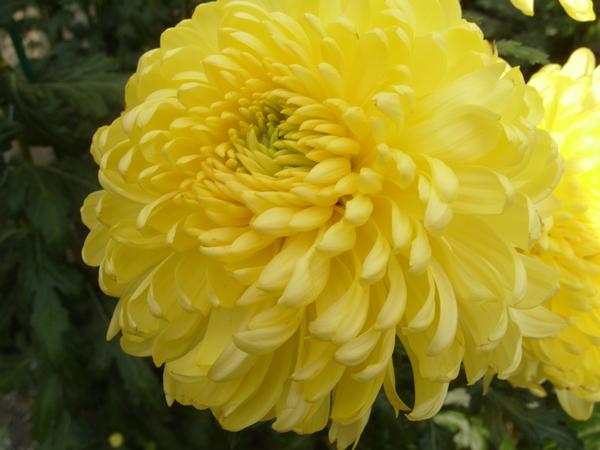

An original variety of chrysanthemum, which has a bud in the form of a lush ball of rich yellow or, less often, lemon shade. Bud girth -18 cm.
Baltika


Variety with medium-sized buds, reaching a diameter of 12 cm.The color of the petals can be yellowish and white, sometimes lemon.
Regalia


An unusual variety that boasts 15 cm deep red buds. The shape is spherical.
Anessie
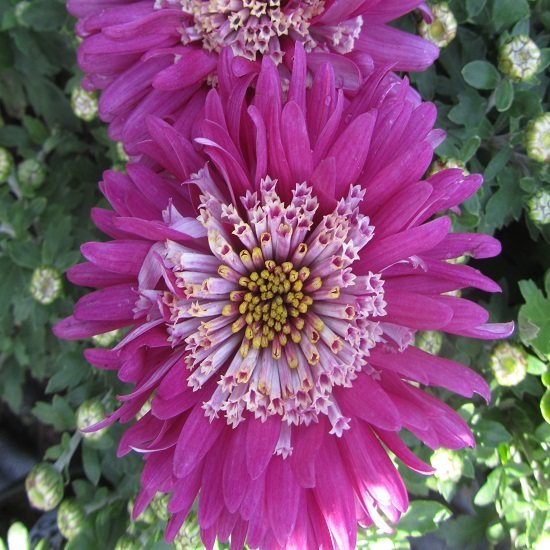

An interesting variety with needle-like petals, with small buds of pink or lemon color.
Zembla


Popular chrysanthemum with chamomile buds in cream, white and yellow shades.
Stern des Orients
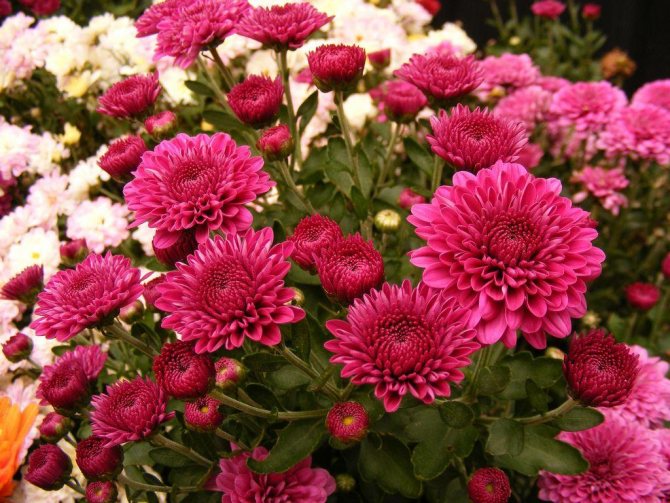

The plant has unusual petals: light yellow at the edges and dark brown towards the base. It begins to bloom in mid-late June and the decorative period lasts until autumn frosts.
Far East
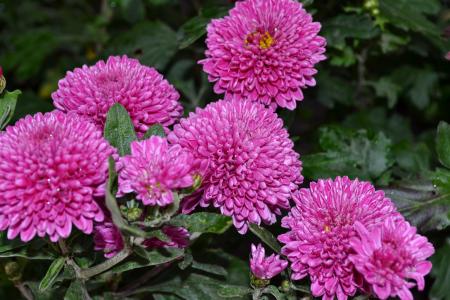

An original variety that forms a sprawling bush half a meter high. The buds are lilac, pompous, terry. The average size of one flower is 5 cm.The variety is not too resistant to unfavorable climates, but it tolerates winter well.
Medium varieties
As mentioned above, these varieties begin to bloom in October and often the flowering period lasts until the first frost.
Orange
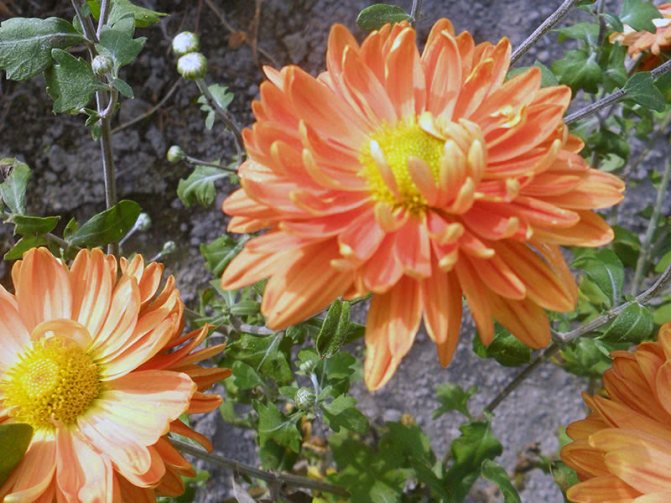

A beautiful chrysanthemum with a spherical bright yellow bud. The diameter of the bud in a fully blossoming state sometimes exceeds 20 cm.
Pink Paradise


As the name implies, this variety boasts pink buds. Chamomile shape.
Clogs
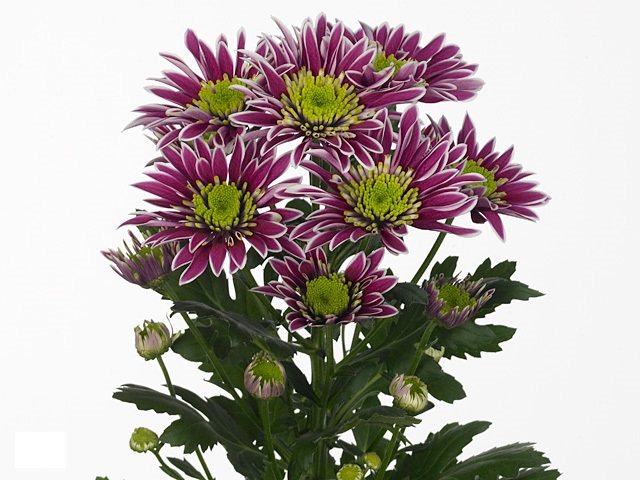

Medium ripening variety with graceful double-colored petals: lilac-white. The shape of the bud is standard, chamomile.
Eleanor


The so-called gerbera variety: a plant in which the characteristics of both gerbera and chrysanthemum are combined. The color of the petals can be pink, yellowish or white, and the diameter of the bud reaches 16 cm.
Amadea
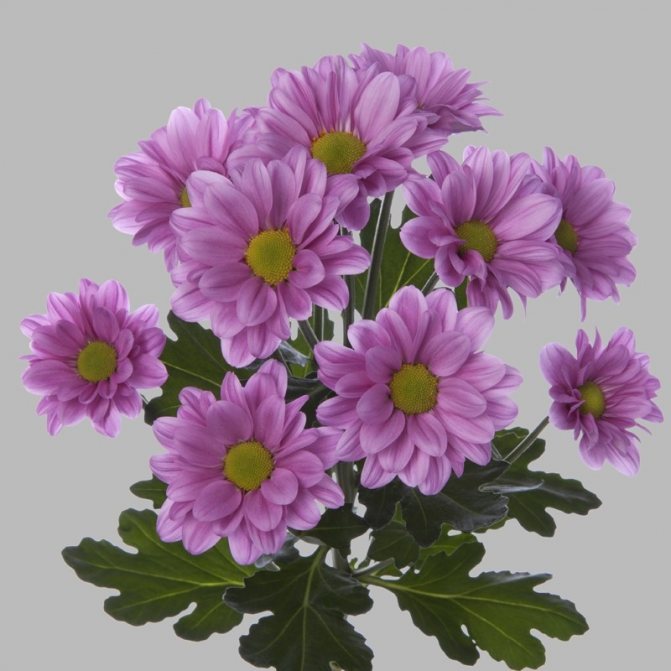

Chrysanthemum, most of all reminiscent of a small lilac chamomile (see photo).
White Stalion


Also a chamomile flower, but already white in color.
Late
Late ripening chrysanthemums are grown mainly in the south of Russia. In more northern areas, they often do not have time to bloom and stand at least for some time.
Ribonet
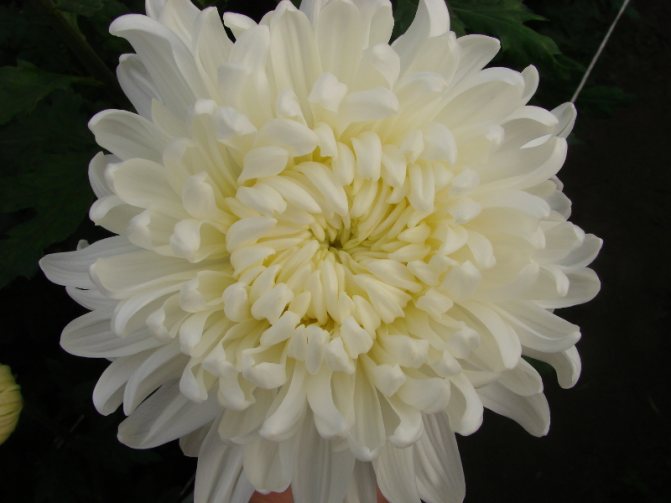

A beautiful spherical flower with snow-white petals. The bud is large, reaching 20 cm in girth.
May Shusmith
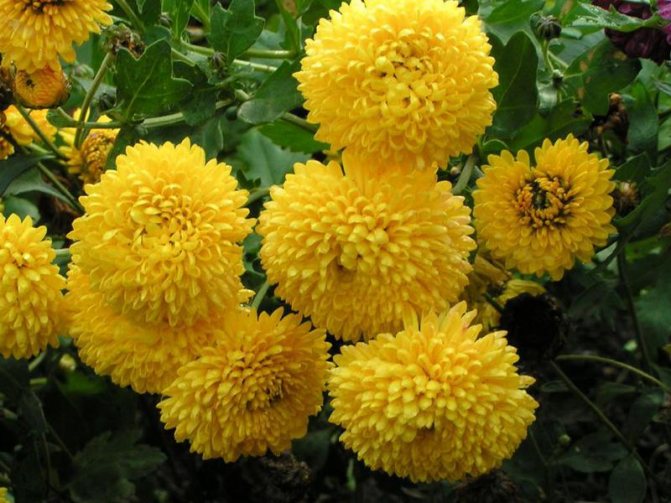

The buds are spherical, regular, with yellow or white petals. Very large flowers: up to 20 cm in girth.
Champagne
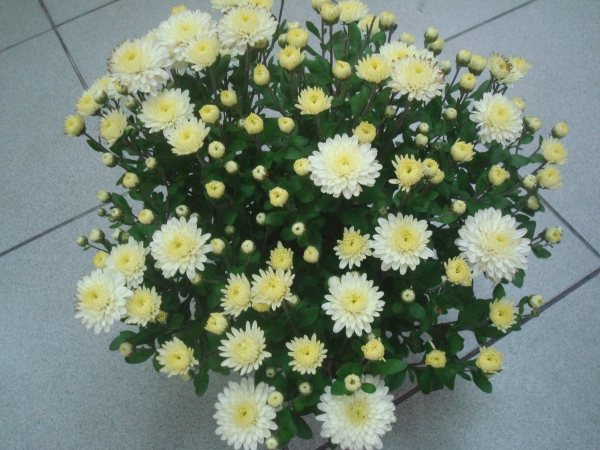

An attractive lilac chrysanthemum with a huge bud, sometimes growing more than 20 cm.
Reproduction
Korean chrysanthemums are propagated in three ways.
Dividing the bush
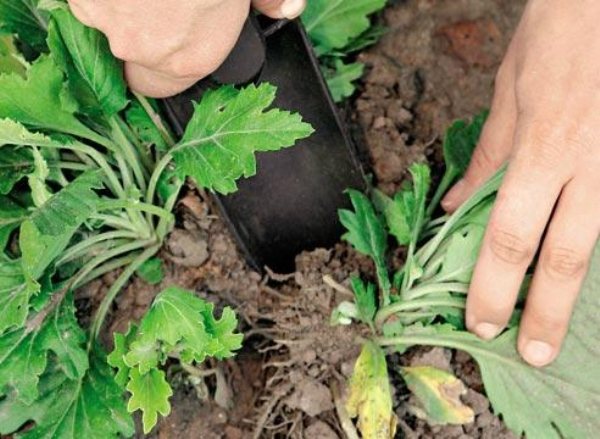

The easiest and less laborious method for breeding Korean chrysanthemums is dividing the bush.
Divide the bushes in the spring, planting cuttings of cut varieties according to the scheme 30x30 cm, and varieties with a spreading bush shape - 40x40 cm.
Cuttings


To get strong cuttings of Korean chrysanthemum, you need to cut off young shoots no longer than 8 cm
Cuttings are carried out in May-June., while the varietal characteristics of plants are preserved.
Sowing seeds
During seed propagation, overwintered seedlings adapt well to low temperatures in a particular region, but they may not correspond to varietal characteristics. For planting, you can buy certain varieties or a ready-made mixture of different seeds to create rainbow colored carpets of chrysanthemums.
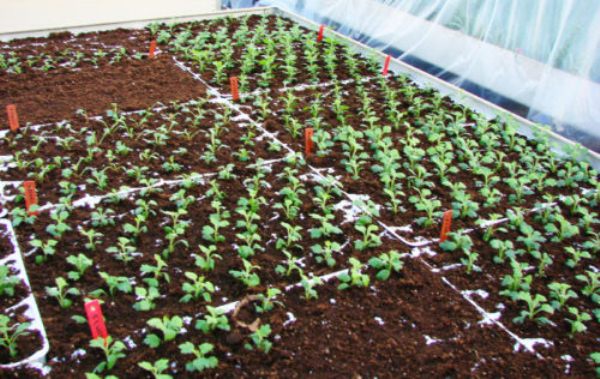

Seeds of Korean chrysanthemum are sown indoors in February
Seeds are harvested as they ripen and left to ripen for 2-3 weeks at a temperature of + 16 + 20 ° С... Seeds are stored at t + 2 + 6 ° C for no more than 2 years - over time, germination is lost.
Varietal characteristics
An annual, herbaceous plant has several qualities:
- lush, forms several branches - the maximum height is about 70 cm;
- stems are fleshy, erect, dark green;
- leaves are emerald, large, cut along the edges, densely cover the stems;
- flower buds of the Alenka Salmon variety of an unusual salmon shade, consist of long reed petals along the edge and small light green petals in the center;
- one or more inflorescences with a diameter of 6-7 cm are formed at the top of the buds;
- flowering occurs in late September or early October.
Possible difficulties
The most common problem in the cultivation of Korean chrysanthemums is fungal diseases. As a rule, the reasons for their appearance can be improper flower care: very low temperatures, excess moisture, strong air humidity or unsuitable soil. Fungal diseases appear in the form of spots - black, white or rust colored. In addition, the stems may rot.
Gardeners recommend using Furacilin or Fitosporin for prevention. During the season, chrysanthemum bushes should be sprayed 2-3 times.In addition, in spring and autumn, you can feed the soil with special antifungal agents. If the flower is already infected with a fungus, it is watered with a double dose of Alirin or Gamair.
Greenhouse pests have become another scourge of the flower. They usually appear when the cuttings are improperly processed or when the soil is poorly sterilized. In the fight against these pests, chemicals have no effect. The only way out is to dig up the affected bush to prevent further infection.
Very often, Korean chrysanthemums are affected by aphids. In this case, the bushes should be sprayed with special chemicals. The same applies to other possible pests - mites, leaf miner, whiteflies and thrips. It should be understood that the fight against parasites that destroy flower bushes does not always bring results.
Lack of space can lead to damage to the leaves, dropping of buds and drying out of the bush. An excess of moisture also leads to the death of the flower. With proper care, feeding and watering, Korean chrysanthemums bloom on average for a month and delight gardeners with lush flowers.
Korean chrysanthemum: growing from seeds
Compatibility
Chrysanthemums, especially in combination with decorative plants that are in harmony in color, texture and growth, are ideal for a landscape style flower garden. An autumn-blooming annual decorative sage with blue flowers looks great next to yellow and bronze chrysanthemums. But I would not plant such a sage next to red chrysanthemums: the contrast is too sharp. But we recommend some varieties of Salvia, such as the Rosebud with delicate pink flowers and all varieties with red flowers that perfectly complement the red chrysanthemums.
Peaked ears of salvia bring variety to the rounded outlines of chrysanthemums. We recommend combining chrysanthemums with non-flowering ornamental plants such as capsicum. Fiesta peppers with small bright orange pods look great next to chrysanthemums. And also tall ornamental grasses, such as Miscanthus sinensis Morning Light, are suitable for chrysanthemums: its leaves are green, and its panicles are bronze. Chrysanthemums can be planted next to brightly colored and variegated plants, such as the sun-loving Coleus, as well as in the vicinity of marigolds and cosmos - after all, they, like chrysanthemums, bloom until the very frost.
The use of pink chrysanthemums in landscape design and floristry
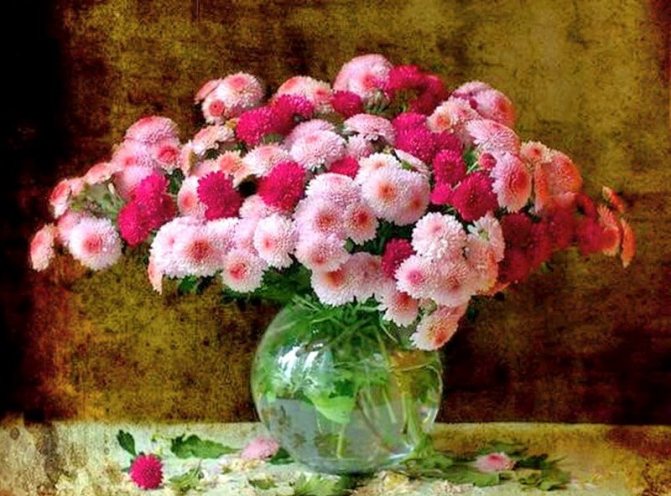

The pink palette includes over 150 shades. Thanks to this variety, chrysanthemums of this color can be completely self-sufficient. A flower bed or rabatka, consisting of different varieties of "autumn queens", shimmering with all the colors of the "pink rainbow" from the delicate color of an angel's wing, almost white with a barely noticeable blush, to a juicy fuchsia color will never look boring and monotonous. A flower bed consisting of chrysanthemums of the same shade of pink will not look boring either. After all, as mentioned earlier, it will radiate positive and fill the surrounding atmosphere with a joyful calm mood and a presentiment of happiness.
In the collection of autumn flowers, chrysanthemums rightfully occupy the most prominent place. Their bright inflorescences adorn gardens and flower beds until the first frost, attracting everyone's attention with the perfection of forms and a variety of shades.
All articles about chrysanthemums on the site can be read by following this link ...
In floristry, the tandem of pink and white flowers is considered the most successful combination. Depending on the purpose of the bouquet, chrysanthemums from the same family or another variety, or roses can be white. The last option is one of the most effective and versatile. It is suitable for a variety of occasions, from a formal event to a romantic date.
Diseases and pests
Vegetative reproduction of chrysanthemums is associated with a significant accumulation of various diseases in their artificial populations. In this case, the greatest damage is caused by viral diseases that cannot be chemically controlled. The spread of viruses dictates the need to constantly maintain a high level of agricultural background, as well as to conduct active breeding work, which allows a quick change of varieties. This problem can be partially solved by multiplying virus-free material in tissue and plant cell culture in vitro.
Among chrysanthemum diseases, fungal diseases are especially destructive. Of these, the most dangerous are various spots, for example, black spot, white spot (mildew), as well as rust fungi, stem rot, root rot, verticillosis, etc. These diseases are especially pronounced when growing conditions are violated - on heavy soils and with excessive humidification, with high air humidity and poor ventilation, low temperatures, etc. Bacterial diseases also cause significant damage to chrysanthemums, of which the most dangerous are bacterial stem rot caused by the bacterium pseudomonas chicory, bacterial wilting caused by chrysanthemum servin, and bacterial cancer, caused by Agrobacterium tumefaciens. The fight against bacterial diseases presents serious difficulties, since most of the available chemicals have antifungal activity. Usually, recommendations come down to the destruction of the affected plant and tough disinfection of the place where it grew.
Chrysanthemums are often affected by many greenhouse pests. Leaf and root nematodes can pose a serious problem, but subject to the rules of agricultural technology, this problem can be solved. Leaf nematodes usually spread when used on cuttings of infected queen cells, and root nematodes when used with poor soil sterilization. Chemical methods of dealing with them are not very effective. Chrysanthemums are actively attacked by several species of aphids, which are also carriers of viruses. Modern drugs make it easy to control the spread of this pest. Leaf miners pose a serious danger to this culture; it is possible to fight them by intensive treatment with chemicals. Thrips, ticks, and whiteflies are also common attacks on chrysanthemums and can be difficult to control.
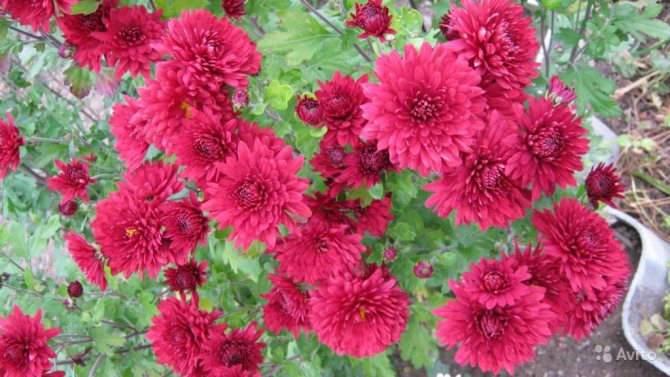

Growing chrysanthemums is often associated with physiological problems. Intensive growth under conditions of a limited nutritional space often leads to various deficiencies, which is expressed in oppression of plant growth, damage to leaves and their death, disruption of bud formation and the development of degenerative flowers. Balanced plant nutrition makes it easy to solve these problems.
Possible reasons for restricting access:
Access is limited by a court decision or on other grounds established by the legislation of the Russian Federation.
The network address that allows you to identify a site on the Internet is included in the Unified Registry of Domain Names, Pointers to Pages of Internet Sites and Network Addresses that allow you to identify sites on the Internet that contain information that is prohibited from being distributed in the Russian Federation.
The network address that allows you to identify a site on the Internet is included in the Registry of domain names, page pointers for sites on the Internet and network addresses that allow you to identify sites on the Internet that contain information distributed in violation of exclusive rights.
What are the cascades of chrysanthemums


The cascading chrysanthemum (ampelous or Morifolium Cascade) was first bred in Japan. Its flowers were similar to those of a daisy 2.5–4 cm in diameter. Today there are many varieties that make up colorful cascades.All of them are distinguished by strong growth and long, flexible shoots with numerous, flowers of various shapes and colors. Today this way of growing "queens of autumn" is very popular in France, Italy and Spain. In these countries, balconies are decorated with lush ampelous flower arrangements in autumn.
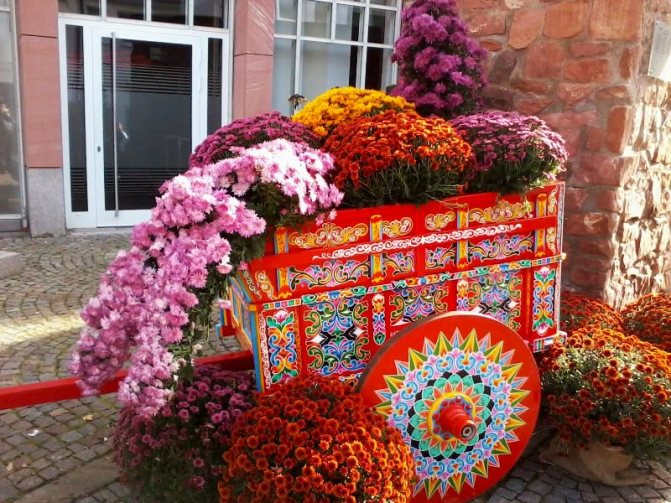

In CCCP, cascading chrysanthemums were grown mainly in botanical gardens. In the 70s of the last century, six varieties of cascade chrysanthemums were tested in the collection of the Main Botanical Garden of the Academy of Sciences of the USSR: Contes de Secourt, Ruissellment d'Or, Cascade d'Orleans, Breeze Japones, Monet, Le Paravan Dore.
Compositions of cascading chrysanthemums are specially formed chrysanthemum bushes, the stems of which do not grow vertically up, but hang down from pots or pots at any angle conceived by the author of this "work". Contrary to the name, if they are not specially formed on a special support, they will grow, as nature should, upwards. Plants can also braid the frames of a wide variety of shapes placed under them. Thus, you can create a variety of curly compositions in the garden, decorated with bright chrysanthemum flowers.
Read also: How to make spruce branches with your own hands
Types and categories
Since there are many varieties of Korean chrysanthemums, they are conventionally divided into the following types:
- Stunted;
- Medium-sized;
- Tall;
- Late;
- Early;
- Not hardy;
- Winter hardy;
- Small-flowered;
- Large-flowered.
Low-growing ones have a second name - border chrysanthemums.


They are miniature, up to 30 cm, suitable for flowerpots and borders. Among the most famous curb varieties, it is worth noting:
Medium-sized varieties reach half a meter in height. These are suitable for elegant bouquets and landscaping. Among them, the most popular are:
Tall varieties among Korean chrysanthemums are not often found.


Sometimes these flowers need to be tied up. Usually tall Korean chrysanthemums are winter-hardy. Among them it is worth mentioning:
Even if we consider that Korean chrysanthemums bloom in the fall, there are also late and early chrysanthemums among them. The latter begin to bloom at the end of summer. Late bloom only when daylight hours begin to decrease and the first cold snaps come.
They are also divided into categories according to the type of flower. They can be terry, pompom, spherical, anemic, semi-double.
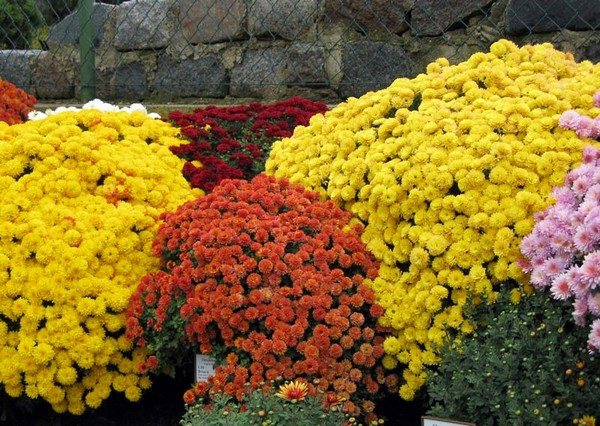

Landing time and conditions
The site for the Korean chrysanthemum must meet the following conditions :
- open well lit (at least 5-6 hours a day) by the sun plot ;
- groundwater do not come close to the surface;
- humus rich soil... loose, air and moisture permeable;
- the area is thoroughly cleaned from weeds and rhizomes;
- acidity index The pH is close to 5.5-6.5.


Korean chrysanthemum takes root well in a new place, and the planting itself and further care of the plant are planned for early spring
The seedlings are transferred to open ground with a lump of earth in April-May - the specific dates depend on the climatic region and weather conditions. Fertile soil is fertilized with rotted manure or compost... heavy relieve with sand. Seeds are sown in February-March, and after 5-6 months, Korean daisies will delight them with their first flowering.
Korean chrysanthemum seedlings purchased in the fall should not be planted in open ground after September 15 - the plant will most likely not survive until spring. You can save the seedling in a dry basement at a temperature of + 2 + 6 ° C. Thermophilic varieties are stored in the same way, digging them up for the winter. A clod of earth is moistened from time to time.



